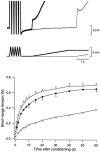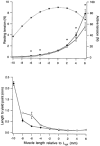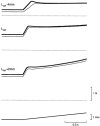Passive mechanical properties of the medial gastrocnemius muscle of the cat
- PMID: 11691881
- PMCID: PMC2278914
- DOI: 10.1111/j.1469-7793.2001.00893.x
Passive mechanical properties of the medial gastrocnemius muscle of the cat
Abstract
1. This is a report on the history dependence of the passive mechanical properties of the medial gastrocnemius muscle of the anaesthetised cat. 2. The muscle was conditioned with an isometric contraction at the test length, or at 3 mm longer than the test length and then returned to the test length, where the level of resting tension was measured, as well as tension changes during a slow stretch. 3. The level of resting tension depended on the form of conditioning and, at the optimum length for active tension, the history-dependent component was 9 % of the total passive tension. 4. During a slow stretch, tension initially rose steeply up to a yield point, beyond which it rose more gradually. The shape of the tension rise depended on the form of conditioning. The level of tension at the yield point consisted of a stretch-dependent component, the 'short-range tension' plus the resting tension for that length. 5. The short-range tension increased with muscle length to peak close to the optimum for active tension. The slope of the tension rise during a stretch, the short-range stiffness, peaked at 2 mm beyond the optimum. 6. The short-range tension was small immediately after a conditioning contraction but grew in size as the interval was increased up to 60 s, with a time constant of 9.9 +/- 0.6 s. After a series of conditioning movements, it recovered more rapidly, with a time constant of 6.6 +/- 0.5 s. 7. The history-dependent changes in passive tension and the response to stretch are interpreted in terms of the presence, in sarcomeres of resting muscle fibres, of crossbridges between actin and myosin which have very slow formation rates, both at rest and during movements.
Figures






References
MeSH terms
Substances
LinkOut - more resources
Full Text Sources
Miscellaneous

